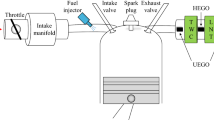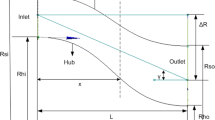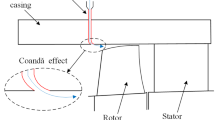Abstract
Supercritical carbon dioxide (S-CO2) Brayton cycle has a wide application prospect. It is significant to optimize the aerodynamic performance of the core part turbine. In this paper, we develop an expected hypervolume improvement (EHVI)-based active learning (EHVI-AL) framework and focus on multi-objective optimization for output power and isentropic efficiency. Firstly, the crowding distance is considered in the candidate samples generation of EHVI evaluation. The power and efficiency of the Pareto front solutions obtained by the EHVI-AL framework are higher than those of other optimization algorithms, and the Pareto front can provide more diverse choices of optimized solutions. Then, considering the cycle economy and output power, the target range of efficiency and power is obtained by unconstrained multi-objective optimization with fewer steps, and the optimization is carried out within this range based on truncated expected hypervolume improvement (tEHVI), which reduces the computational cost by 50%. Finally, considering the turbine mass flow variation may cause surge or choke of the compressor as well as uneven pressure ratio distribution in multi-stage compressor, the range of the turbine mass flow is set and the multi-objective optimization with the mass flow constraint is realized by the constrained expectation hypervolume improvement (cEHVI). The EHVI-AL framework adopted in this paper provides an efficient way to optimize the aerodynamic performance of a S-CO2 turbine, and the modification of EHVI can effectively take into account the effects of Brayton cycle and deal with the power, efficiency, and flow constraints in real situations.
















Similar content being viewed by others
Abbreviations
- RGP:
-
Real gas properties
- SST:
-
Shear stress transfer
- \(f\) :
-
Objective function
- \(c\) :
-
Constraints
- \(L\) :
-
Lower boundary of design parameters
- \(U\) :
-
Upper boundary of design parameters
- \(\mu ,{{\varvec{\upmu}}}\),:
-
Mean or mean matrix
- \(\sigma ,{{\varvec{\upsigma}}}\) :
-
Standard deviation or standard deviation matrix
- \({\mathbf{k}}\) :
-
Covariance matrix
- \({\mathbf{x}}^{*}\) :
-
Test input vector
- \({\mathbf{X}}\) :
-
Train set input matrix
- \({\mathbf{Y}}\) :
-
Response to input matrix
- \(\lambda_{d}\) :
-
Lebesgue measure
- \({\mathbf{y}}\) :
-
Newly added vector
- \({\mathbf{r}}\) :
-
Reference point
- \({\mathbf{P}}\) :
-
Pareto set
- \({\text{HVI}}\) :
-
Hypervolume improvement
- \({\text{PDF}}\) :
-
Probability density function
- \({\text{tPDF}}\) :
-
Truncated probability density function
- \(l_{c}\) :
-
Crowding distance
- \(l\) :
-
Lower boundary of slice area
- \(u\) :
-
Upper boundary of slice area
- \(x\) :
-
Profile geometry parameter
- \(s\) :
-
Standard deviation of the random search
- \(R_{{{\text{in}}}}\) :
-
Inlet radius of rotor
- \(R_{{{\text{out}}}}\) :
-
Outlet radius of rotor
- \(H\) :
-
Height of blade
- \(n\) :
-
Number of blades
- \(d\) :
-
Distance between two adjacent points
- \(P\) :
-
Output power
- \(T_{z}\) :
-
Torque on rotor blade
- \(\eta_{is}\) :
-
Isentropic efficiency of turbine rotor
- r :
-
Rotation speed
- \(\dot{m}\) :
-
Mass flow
- \(\eta_{s}^{*}\) :
-
Isentropic efficiency of compressor stage
- \(\pi^{*}\) :
-
Stage inlet and outlet pressure ratio
References
Abdolshah M, Shilton A, Rana S, Gupta S, Venkatesh S (2018) Expected hypervolume improvement with constraints. 2018 24th International Conference on Pattern Recognition (ICPR). pp 3238–3243. https://doi.org/10.1109/ICPR.2018.8545387.
Bansal S, Calandra R, Xiao T, Levine S, Tomlin CJ (2017) Goal-driven dynamics learning via Bayesian optimization. 2017 IEEE 56th Annual Conference on Decision and Control (CDC). pp 5168–5173. https://doi.org/10.1109/CDC.2017.8264425.
Bassman L, Rajak P, Kalia RK, Nakano A, Sha F, Sun J, Singh DJ, Aykol M, Huck P, Persson K (2018) Active learning for accelerated design of layered materials. Npj Comput Mater 4:1–9. https://doi.org/10.1038/s41524-018-0129-0
Chan CM, Bai H, He D (2018) Blade shape optimization of the Savonius wind turbine using a genetic algorithm. Appl Energy 213:148–157. https://doi.org/10.1016/j.apenergy.2018.01.029
Chen X, Agarwal R (2012) Optimization of flatback airfoils for wind-turbine blades using a genetic algorithm. J Aircr 49:622–629. https://doi.org/10.2514/1.C031614
Cho S K, Kim M, Baik S, Ahn Y, Lee JI (2015) Investigation of the bottoming cycle for high efficiency combined cycle gas turbine system with supercritical carbon dioxide power cycle. ASME turbo expo 2015: turbine technical conference and exposition. https://doi.org/10.1115/GT2015-43077
Collette Y, Siarry P (2005) Three new metrics to measure the convergence of metaheuristics towards the Pareto frontier and the aesthetic of a set of solutions in biobjective optimization. Comput Oper Res 32:773–792. https://doi.org/10.1016/j.cor.2003.08.017
Couckuyt I, Deschrijver D, Dhaene T (2014) Fast calculation of multiobjective probability of improvement and expected improvement criteria for Pareto optimization. J Glob Optim 60:575–594. https://doi.org/10.1007/s10898-013-0118-2
Crespi F, Gavagnin G, Sánchez D, Martínez GS (2017) Supercritical carbon dioxide cycles for power generation: a review. Appl Energy 195:152–183. https://doi.org/10.1016/j.apenergy.2017.02.048
Daulton S, Balandat M, Bakshy E (2020) Differentiable expected hypervolume improvement for parallel multi-objective Bayesian optimization. Adv Neural Inf Process Syst 33:9851–9864
Deb K, Pratap A, Agarwal S, Meyarivan T (2002) A fast and elitist multiobjective genetic algorithm: NSGA-II. IEEE Trans Evol Comput 6:182–197. https://doi.org/10.1109/4235.996017
Du X, Yu D, Luo D, Huang D (2019) Supercritical carbon dioxide centripetal compressor—aerodynamic design and analysis of off design conditions. J Nucl Eng Radiat Sci. https://doi.org/10.1115/1.4043846
Du Y, Yang C, Wang H, Hu C (2021) One-dimensional optimisation design and off-design operation strategy of centrifugal compressor for supercritical carbon dioxide Brayton cycle. Appl Therm Eng 196:117318. https://doi.org/10.1016/j.applthermaleng.2021.117318
Emmerich M (2005). Single-and multi-objective evolutionary design optimization assisted by gaussian random field metamodels. Dortmund, Univ., Diss., 2005
Fletcher R (1970) A new approach to variable metric algorithms. Comput J 13:317–322. https://doi.org/10.1093/comjnl/13.3.317
Forrester AIJ, Keane AJ (2009) Recent advances in surrogate-based optimization. Prog Aerosp Sci 45:50–79. https://doi.org/10.1016/j.paerosci.2008.11.001
Huang X, Chen J, Zhu H (2016) Assessing small failure probabilities by AK–SS: an active learning method combining kriging and subset simulation. Struct Saf 59:86–95. https://doi.org/10.1016/j.strusafe.2015.12.003
Ji Y, Yang Z, Ran J, Li H (2021) Multi-objective parameter optimization of turbine impeller based on RBF neural network and NSGA-II genetic algorithm. Energy Rep 7:584–593. https://doi.org/10.1016/j.egyr.2021.10.003
Jones DR, Schonlau M, Welch WJ (1998) Efficient global optimization of expensive black-box functions. J Glob Optim 13:455–492. https://doi.org/10.1023/A:1008306431147
Kroetz HM, Moustapha M, Beck AT, Sudret B (2020) A two-level kriging-based approach with active learning for solving time-variant risk optimization problems. Reliab Eng Syst Saf 203:107033. https://doi.org/10.1016/j.ress.2020.107033
Kushner HJ (1964) A new method of locating the maximum point of an arbitrary multipeak curve in the presence of noise. J Basic Eng 86:97–106. https://doi.org/10.1115/1.3653121
Li J-Y, Li R, Gao Y, Huang J (2010) Aerodynamic optimization of wind turbine airfoils using response surface techniques. Proc Inst Mech Eng a: J Power Energy 224:827–838. https://doi.org/10.1243/09576509JPE888
Li M-J, Zhu H-H, Guo J-Q, Wang K, Tao W-Q (2017) The development technology and applications of supercritical CO2 power cycle in nuclear energy, solar energy and other energy industries. Appl Therm Eng 126:255–275. https://doi.org/10.1016/j.applthermaleng.2017.07.173
Luo D, Liu Y, Sun X, Huang D (2017) The design and analysis of supercritical carbon dioxide centrifugal turbine. Appl Therm Eng 127:527–535. https://doi.org/10.1016/j.applthermaleng.2017.08.039
Mellal MA, Pecht M (2020) A multi-objective design optimization framework for wind turbines under altitude consideration. Energy Convers Manag 222:113212. https://doi.org/10.1016/j.enconman.2020.113212
Mirjalili S, Saremi S, Mirjalili SM, Coelho LdS (2016) Multi-objective grey wolf optimizer: a novel algorithm for multi-criterion optimization. Expert Syst Appl 47:106–119. https://doi.org/10.1016/j.eswa.2015.10.039
Mirjalili SZ, Mirjalili S, Saremi S, Faris H, Aljarah I (2018) Grasshopper optimization algorithm for multi-objective optimization problems. Appl Intell 48:805–820. https://doi.org/10.1007/s10489-017-1019-8
Neto JXV, Junior EJG, Moreno SR, Ayala HVH, Mariani VC, dos Santos CL (2018) Wind turbine blade geometry design based on multi-objective optimization using metaheuristics. Energy 162:645–658. https://doi.org/10.1016/j.energy.2018.07.186
Palar PS, Yang K, Shimoyama K, Emmerich M, Bäck T (2018) Multi-objective aerodynamic design with user preference using truncated expected hypervolume improvement. Proc Genet Evol Comput Conf. https://doi.org/10.1145/3205455.3205497
Pedregosa F, Varoquaux G, Gramfort A, Michel V, Thirion B, Grisel O, Blondel M, Prettenhofer P, Weiss R, Dubourg V (2011) Scikit-learn: machine learning in Python. J Mach Learn Res 12:2825–2830. https://doi.org/10.5555/1953048.2078195
Posteljnik Z, Stupar S, Svorcan J, Peković O, Ivanov T (2016) Multi-objective design optimization strategies for small-scale vertical-axis wind turbines. Struct Multidisc Optim 53:277–290. https://doi.org/10.1007/s00158-015-1329-6
Qin Y, Li D, Wang H, Liu Z, Wei X, Wang X (2022) Multi-objective optimization design on high pressure side of a pump-turbine runner with high efficiency. Renew Energy 190:103–120. https://doi.org/10.1016/j.renene.2022.03.085
Rasmussen CE (2003) Gaussian processes in machine learning. Summer Sch Machi Learn. https://doi.org/10.1007/978-3-540-28650-9_4
Reyes-Belmonte MA, Sebastián A, Romero M, González-Aguilar J (2016) Optimization of a recompression supercritical carbon dioxide cycle for an innovative central receiver solar power plant. Energy 112:17–27. https://doi.org/10.1016/j.energy.2016.06.013
Ruiz-Casanova E, Rubio-Maya C, Pacheco-Ibarra JJ, Ambriz-Díaz VM, Romero CE, Wang X (2020) Thermodynamic analysis and optimization of supercritical carbon dioxide Brayton cycles for use with low-grade geothermal heat sources. Energy Convers Manag 216:112978. https://doi.org/10.1016/j.enconman.2020.112978
Schott JR (1995) Fault tolerant design using single and multicriteria genetic algorithm optimization. Massachusetts Institute of Technology
Settles B (2009) Active learning literature survey
Shanno DF (1970) Conditioning of quasi-Newton methods for function minimization. Math Comput 24:647–656. https://doi.org/10.1090/S0025-5718-1970-0274029-X
Srinivas N, Krause A, Kakade SM, Seeger M (2009) Gaussian process optimization in the bandit setting: no regret and experimental design. arXiv preprint arXiv:09123995, https://doi.org/10.48550/arXiv.0912.3995
Wang X-F, Xi G, Wang Z-H (2006) Aerodynamic optimization design of centrifugal compressor’s impeller with Kriging model. Proc Inst Mech Eng a: J Power Energy 220:589–597. https://doi.org/10.1243/09576509JPE201
Wang L, Wang T-g, Luo Y (2011) Improved non-dominated sorting genetic algorithm (NSGA)-II in multi-objective optimization studies of wind turbine blades. Appl Math Mech 32:739–748. https://doi.org/10.1007/s10483-011-1453-x
Wang Y, Li J, Zhang D, Xie Y (2020) Numerical investigation on aerodynamic performance of SCO2 and air radial-inflow turbines with different solidity structures. Appl Sci 10:2087. https://doi.org/10.3390/app10062087
Wang Y, Li Y, Zhang D, Xie Y (2021a) Aerodynamic optimization of a SCO-2 radial-inflow turbine based on an improved simulated annealing algorithm. Proc Inst Mech Eng a: J Power Energy 235:1039–1052. https://doi.org/10.1177/0957650920976666
Wang Y, Liu T, Zhang D, Xie Y (2021b) Dual-convolutional neural network based aerodynamic prediction and multi-objective optimization of a compact turbine rotor. Aerosp Sci Technol 116:106869. https://doi.org/10.1016/j.ast.2021.106869
Wu P, Ma Y, Gao C, Liu W, Shan J, Huang Y, Wang J, Zhang D, Ran X (2020) A review of research and development of supercritical carbon dioxide Brayton cycle technology in nuclear engineering applications. Nucl Eng Des 368:110767. https://doi.org/10.1016/j.nucengdes.2020.110767
Yang K, Gaida D, Bäck T, Emmerich M (2015) Expected hypervolume improvement algorithm for PID controller tuning and the multiobjective dynamical control of a biogas plant. 2015 IEEE Congress on Evolutionary Computation (CEC). Appl Energy, pp 1934–1942. https://doi.org/10.1109/CEC.2015.7257122
Yang K, Deutz A, Yang Z, Back T, Emmerich M (2016) Truncated expected hypervolume improvement: exact computation and application. 2016 IEEE Congress on Evolutionary Computation (CEC). pp 4350–4357. https://doi.org/10.1109/CEC.2016.7744343.
Yang K, Emmerich M, Deutz A, Fonseca CM (2017) Computing 3-D expected hypervolume improvement and related integrals in asymptotically optimal time. Int Conf Evol Multi-Criterion Optim. https://doi.org/10.1007/978-3-319-54157-0_46
Zhang XR, Yamaguchi H (2008) An experimental study on evacuated tube solar collector using supercritical CO2. Appl Therm Eng 28:1225–1233. https://doi.org/10.1016/j.applthermaleng.2007.07.013
Zhonghe H, Xiaoqiang J, Peng L (2019) Preliminary design of radial inflow turbine and working fluid selection based on particle swarm optimization. Energy Convers Manag 199:111933. https://doi.org/10.1016/j.enconman.2019.111933
Zuhal LR, Faza GA, Palar PS, Shimoyama K (2019a) Multi-objective kriging-based optimization for high-fidelity wind turbine design. AIAA Scitech 2019 Forum. https://doi.org/10.2514/6.2019-0539
Zuhal LR, Palar PS, Shimoyama K (2019b) A comparative study of multi-objective expected improvement for aerodynamic design. Aerosp Sci Technol 91:548–560. https://doi.org/10.1016/j.ast.2019.05.044
Acknowledgements
This work was support by 111 Project of Chinese Ministry of Education (Grant No. B16038).
Author information
Authors and Affiliations
Contributions
PW contributed to methodology, formal analysis, investigation, resources, and writing—original draft. YW contributed to conceptualization, software, and data curation. TL: contributed to validation, writing—review and editing, and visualization. DZ contributed to supervision, project administration, and funding acquisition.
Corresponding author
Ethics declarations
Conflict of interest
The authors declare that they have no conflict of interest.
Replications of results
The information needed to replicate the results exists in the manuscript. The calculation methods of various expected hypervolume improvement can be referred to the literature (Yang et al. 2016, 2017).
Additional information
Responsible Editor: Emilio Carlos Nelli Silva
Publisher's Note
Springer Nature remains neutral with regard to jurisdictional claims in published maps and institutional affiliations.
Rights and permissions
Springer Nature or its licensor holds exclusive rights to this article under a publishing agreement with the author(s) or other rightsholder(s); author self-archiving of the accepted manuscript version of this article is solely governed by the terms of such publishing agreement and applicable law.
About this article
Cite this article
Wang, P., Wang, Y., Liu, T. et al. Active learning-based multi-objective optimization for aerodynamic performance of a supercritical carbon dioxide turbine. Struct Multidisc Optim 65, 267 (2022). https://doi.org/10.1007/s00158-022-03391-x
Received:
Revised:
Accepted:
Published:
DOI: https://doi.org/10.1007/s00158-022-03391-x




